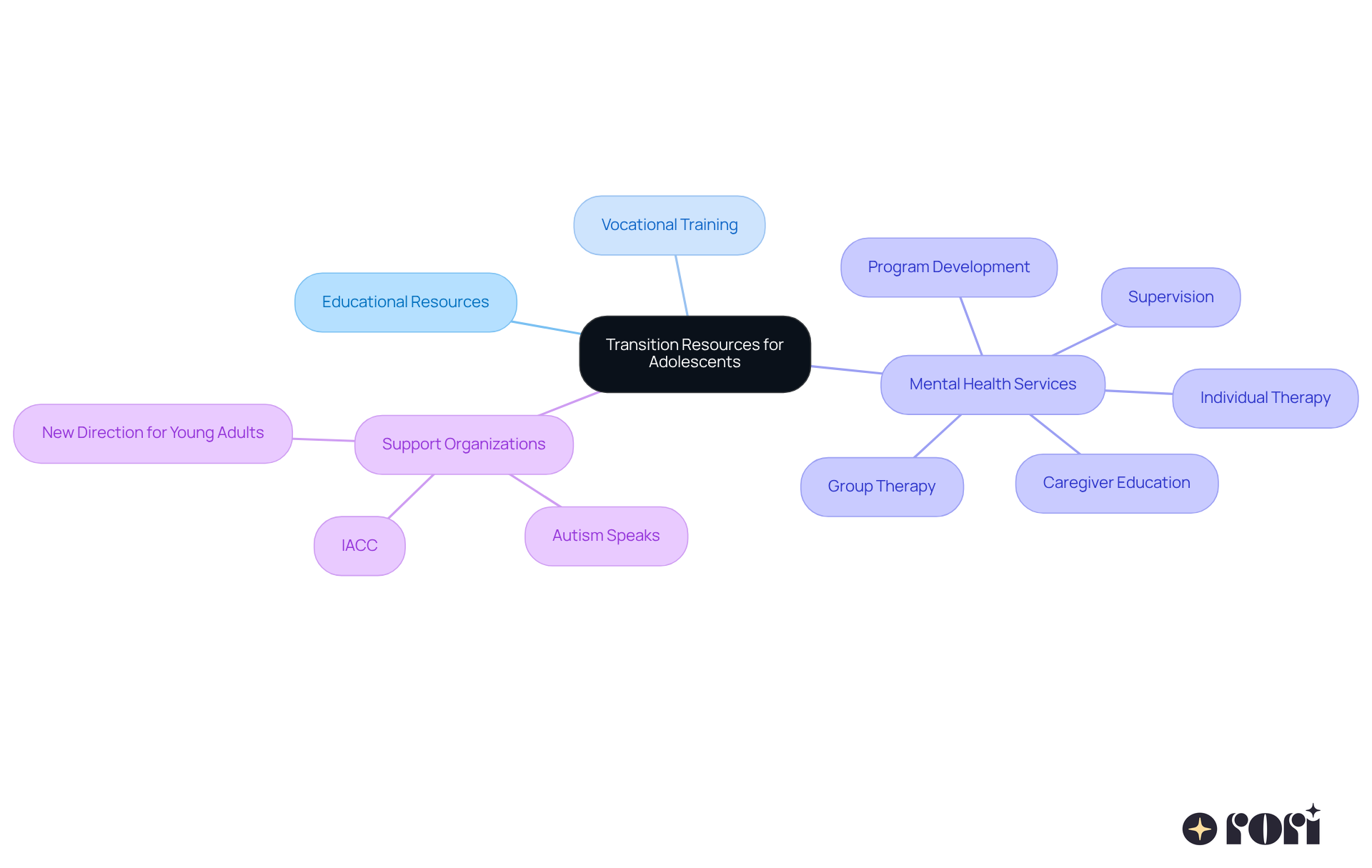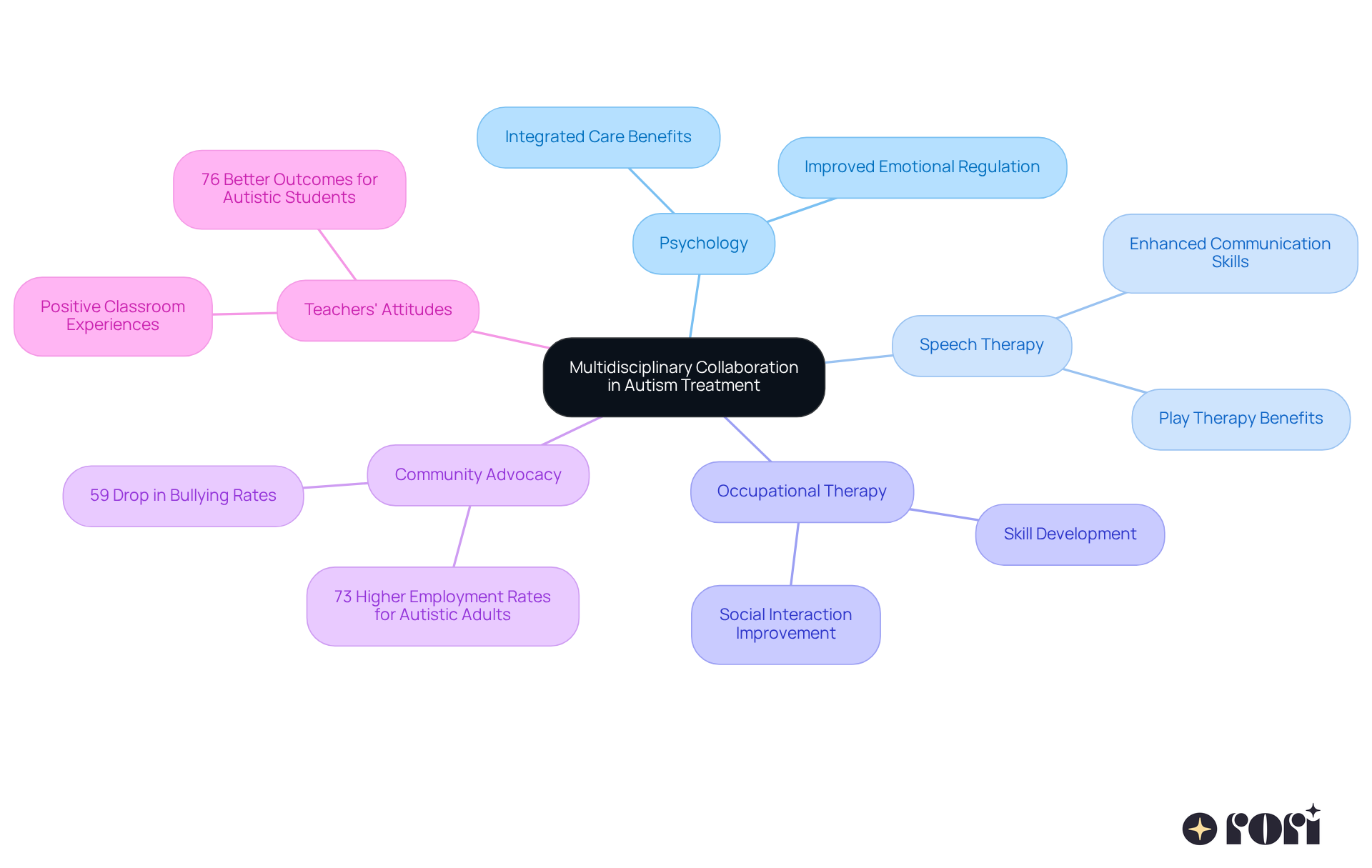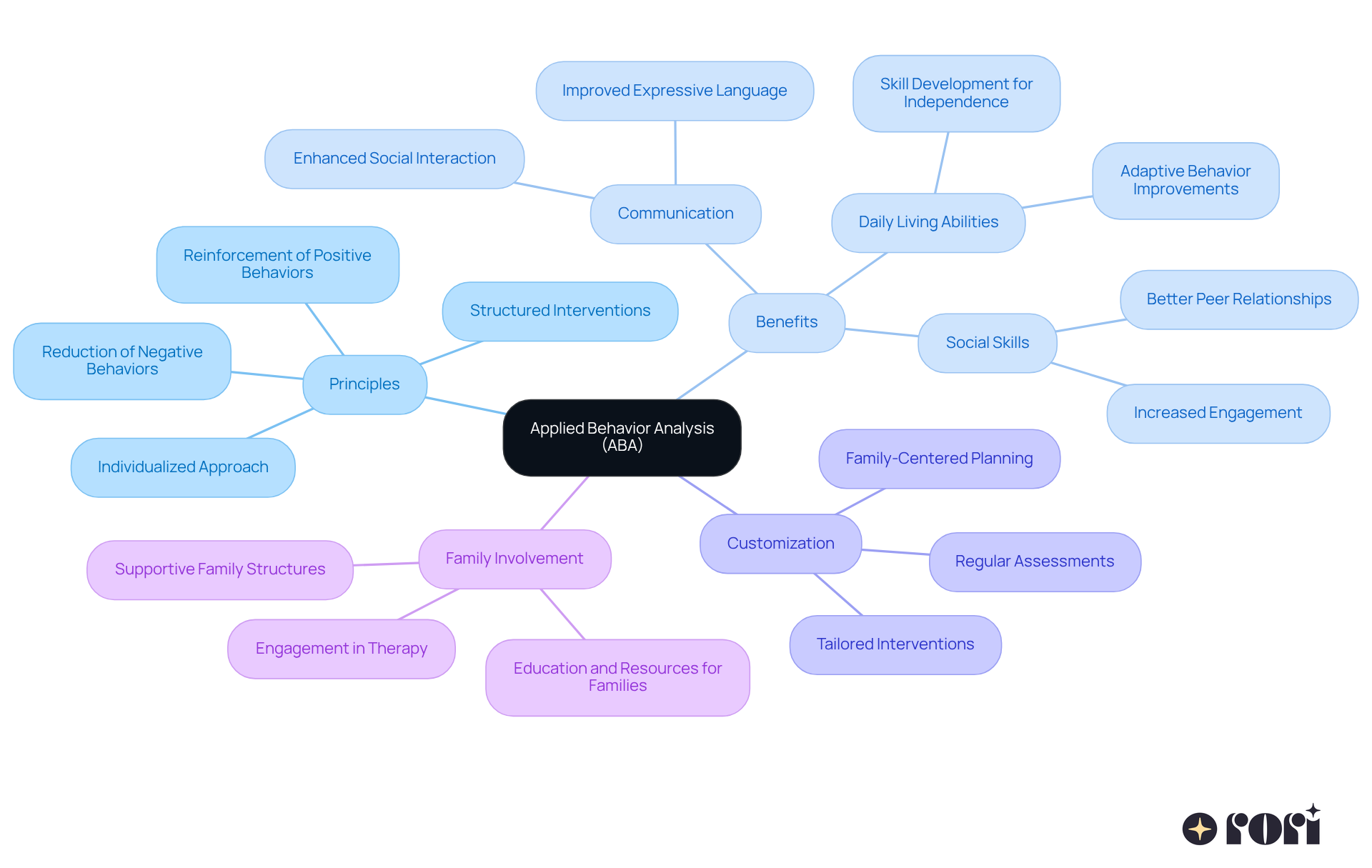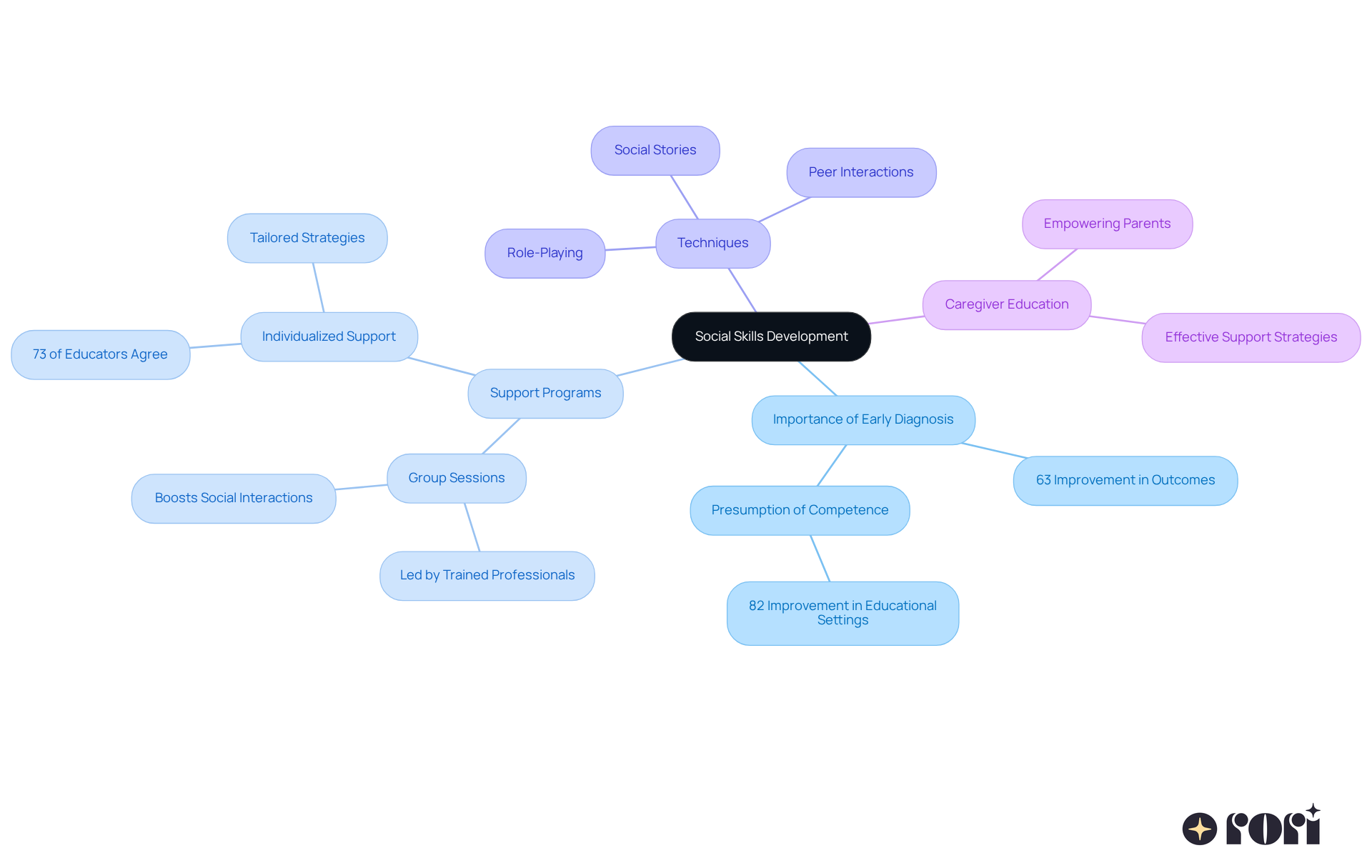Navigating the complexities of autism care for transitioning adolescents can feel overwhelming for families. But with the right resources and support systems, this journey can turn into an empowering experience that nurtures independence and growth.
Let’s explore ten essential autism care resources that offer invaluable assistance to both adolescents and their families. These resources cover everything from personalized therapy options to effective parenting strategies.
What challenges might parents face in ensuring their children receive the best possible support during this critical transition? And how can these resources help bridge that gap? We’re here to help you every step of the way!
At Rori Care, we understand that navigating the world of autism support can be challenging for parents. That’s why we embrace a comprehensive approach to ABA support, focusing on customized treatment strategies that incorporate autism care resources for transitioning adolescents tailored to their unique needs. 🌟
Using advanced technology and data-informed methods, we make each session engaging and effective. This personalized strategy not only addresses behavioral challenges but also helps cultivate essential social skills and independence, which are key components of autism care resources for transitioning adolescents.
Research shows that personalized ABA treatment can lead to significant improvements in communication and adaptive behaviors, with success rates often exceeding 89%! Isn’t that encouraging? Plus, the integration of technology in therapy, like telehealth and data analytics, is revolutionizing care for individuals with developmental disorders, making it more accessible and effective for families.
As the demand for tailored autism care resources for transitioning adolescents continues to grow, Rori Care is here to ensure that every young person receives the support they need to thrive. Let’s explore this journey together! We’re here to help you every step of the way!

Transitioning to adulthood can feel overwhelming for adolescents with autism, can’t it? That’s why having a solid support system is so important. Think about it: autism care resources for transitioning adolescents, including educational resources, vocational training, and mental health services, all play a crucial role in this journey. At Rori Care, we’re here to empower your young one with the skills they need to navigate the world independently. We focus on fostering autonomy through essential skill development.
Our mental health services include:
Each of these is designed to support your unique needs during this critical transition. It’s all about finding what works best for your family! Organizations like Autism Speaks and the IACC offer fantastic toolkits and guides that serve as autism care resources for transitioning adolescents to help you plan for your child's future. These autism care resources for transitioning adolescents cover everything from postsecondary education options to employment support, ensuring that adolescents have the necessary tools to thrive.
Let’s explore this together! We’re here to help you every step of the way!

When it comes to autism treatment, multidisciplinary collaboration is key! It brings together professionals from various fields like psychology, speech therapy, and occupational therapy. At Rori Care, our clinical leadership team is made up of talented and compassionate individuals who truly value neurodiversity. Every day, they work hard to help children thrive.
This integrated approach looks at all aspects of a young person’s development, leading to more comprehensive and effective care. By sharing insights and strategies, these professionals can create tailored interventions that meet the unique needs of each child. This teamwork can really make a difference in treatment outcomes!
Did you know that communities with strong advocacy programs for individuals with developmental disorders see a 59% drop in bullying rates? That’s a powerful testament to the benefits of collaborative care! Plus, studies show that when teachers have positive attitudes, autistic students experience 76% better outcomes. It’s clear that teamwork in educational settings is crucial.
But it doesn’t stop there! This collaboration not only enhances individual treatment results but also creates an environment where 65% of autistic adults feel they receive meaningful support from those who understand their unique journey. Ultimately, these collaborative efforts empower families by promoting the overall well-being of autistic youth through the use of autism care resources for transitioning adolescents. They also enhance caregiver education, informed decision-making, and improved behavioral outcomes.
Let’s explore this together! We’re here to help you every step of the way!

When it comes to supporting individuals on the autism spectrum, evidence-based practices are key to ensuring that interventions are effective and reliable. For instance, methods like Applied Behavior Analysis (ABA) and Cognitive Behavioral Therapy (CBT) have shown some pretty impressive results for young people. Research tells us that early and intensive interventions, especially those that use ABA principles, can lead to significant improvements in cognitive, language, and daily living skills. Did you know that about 45% of long-term effective therapies incorporate ABA techniques? Kids who receive early ABA intervention before the age of four often show remarkable progress in their social skills and communication.
Now, let’s talk about CBT. This approach has gained recognition for its effectiveness in addressing anxiety and behavioral challenges in young individuals with developmental disorders. It helps them develop healthier coping strategies and better emotional control. By integrating these evidence-based methods, we not only improve behavioral and social outcomes but also empower families to make informed choices about autism care resources for transitioning adolescents. As the demand for effective therapies continues to grow, it’s crucial for parents to stay updated on the latest research and successful applications, including autism care resources for transitioning adolescents, of ABA and CBT. This knowledge can really help young people transition into adulthood smoothly, especially when utilizing autism care resources for transitioning adolescents.
So, let’s explore this together! Understanding these practices can make a world of difference for your child and your family.

Parents play a crucial role in the care and development of their autistic teens, and there’s a wealth of resources out there to support you on this journey. Support groups, like those organized by the Autism Society, create a wonderful sense of community. They allow parents to share experiences and strategies, offering not just emotional support but also a space to exchange valuable information on managing the challenges that come with caring for a developmental disorder. This can really help ease stress and improve family dynamics.
Educational workshops and online forums are fantastic ways to empower parents, providing insights into advocacy, rights, and effective strategies for supporting your child. Local autism resource centers are also available, offering tools to help families understand their unique needs and promote their development. For example, you can learn about the importance of early intervention and how to use positive reinforcement techniques at home.
Plus, advocating for your autistic child is so important! Engaging actively in their education and therapy processes can make a big difference. This means collaborating with educators and therapists to set clear, measurable goals that cater to your child’s strengths and challenges. By utilizing autism care resources for transitioning adolescents and support networks, you can significantly enhance your child’s transition to adulthood, ensuring they get the care and opportunities they need to thrive.
Let’s explore this together! You’re not alone in this journey, and there’s a community ready to support you every step of the way!

Navigating healthcare can be quite a journey for families with autistic teenagers, especially when utilizing autism care resources for transitioning adolescents that address co-occurring conditions like anxiety, depression, and sensory processing issues. At Rori Care, our dedicated clinicians are here to walk alongside you, offering comprehensive and compassionate Applied Behavior Analysis (ABA) treatment.
It’s so important for families to team up with healthcare providers to create a care plan that truly meets their needs. Regular check-ups, mental health support, and tailored treatments - like group sessions and one-on-one support - can really boost the overall well-being of your adolescent. With active participation from caregivers, about 90% of youngsters show significant improvement in their treatment. This really highlights how effective ABA therapy can be in supporting developmental disorders.
Let’s explore this together! We’re here to help you every step of the way!
Applied Behavior Analysis (ABA) is a fantastic treatment for autism spectrum disorder that really focuses on reinforcing positive behaviors while gently reducing the negative ones. It’s all about structured interventions tailored to fit each child’s unique needs, using the science of learning and behavior. When families fully engage with the recommended hours, it’s amazing to see that 90% of young individuals make significant progress!
This evidence-based approach can truly enhance communication, social skills, and daily living abilities in young people. If you’re considering ABA for your child, it’s helpful to understand its principles and how it can be customized just for them. Especially in the context of early intensive behavioral intervention (EIBI), it can make a real difference in improving learning and social skills.
Let’s explore this together! Understanding ABA can feel overwhelming, but you’re not alone in this journey. Many families have walked this path and found success, and we’re here to help you every step of the way!

Developing social skills is essential for adolescents with autism care resources for transitioning adolescents as they strive for independence. You know, research shows that when kids accept their diagnosis early and get the right support, they can see a 63% improvement in social skills training outcomes! Programs that focus on social skills group sessions, led by trained professionals, really help individuals improve their social interactions and communication in a group setting. This not only boosts their competence but also helps them build better relationships.
Techniques like role-playing, social stories, and peer interactions work wonders in enhancing these skills and building the confidence needed to engage with peers. Plus, educating caregivers is key! When parents have the right knowledge and strategies, they can support their children more effectively. It’s heartening to see that 73% of educators agree that individualized support makes a big difference for all students.
As Dr. Temple Grandin wisely says, "The most interesting people you’ll find are ones that don’t fit into your average cardboard box." By nurturing these essential skills through organized group support and involving caregivers, teenagers with developmental disorders can better prepare for the challenges of adulthood by utilizing autism care resources for transitioning adolescents. This ultimately leads to greater independence and a better quality of life. Let’s explore this together!

Technology is really changing the game when it comes to autism treatment! With innovative tools for behavior modification, things like gamification, virtual reality, and AI-driven analytics are making treatment sessions more engaging and motivating. For example, gamified interventions have shown a positive impact on social interaction and communication. Studies even show a pooled standardized mean difference of 0.46, which suggests some pretty significant improvements in these areas.
These tech-enhanced strategies create a more interactive learning environment and help track progress in a personalized way. Thanks to automatic data collection and secure storage, therapists can adjust interventions based on real-time data, ensuring that each child’s unique needs are met effectively. Plus, with AI in ABA treatment, therapists can generate progress reports automatically, freeing up to 50% more time for child care. That’s a big win for everyone involved!
And let’s not forget about virtual reality! It offers immersive experiences for practicing social skills in controlled settings, which can really boost confidence and improve social interactions. All in all, integrating these advanced technologies is paving the way for more effective and tailored autism care resources for transitioning adolescents. So, let’s explore this together and see how these tools can make a difference!

Fostering independence in autistic teenagers is a journey that requires a thoughtful approach to teaching essential life skills, supported by autism care resources for transitioning adolescents. At Rori Care - ABA Therapy, we’re all about empowering your child with the skills they need to navigate the world confidently. Our individualized behavior intervention plans are designed just for them!
We use structured programs that incorporate visual supports, task analysis, and the gradual fading of prompts. These methods have shown great success in helping adolescents pick up these vital skills. Dr. Stephen Shore wisely reminds us, "If you’ve met one person with autism, you’ve met one person with autism." This really highlights how important it is to tailor strategies to fit each unique individual.
Research shows that utilizing autism care resources for transitioning adolescents can significantly boost the ability of autistic youth to manage daily tasks. This, in turn, helps build their confidence and competence as they transition into adulthood using autism care resources for transitioning adolescents. Celebrating those small milestones along the way is so important! It reinforces the positive impact of structured programs on building self-esteem.
By focusing on practical, everyday activities and creating steady routines, families can help their youngsters tackle the challenges of adult life. And let’s not forget the power of communication! Parents are encouraged to have regular chats with their children about their goals and dreams. This fosters an environment of open dialogue and support.
Let’s explore this together! We’re here to help you every step of the way!

Transitioning adolescents with autism into adulthood is quite a journey, isn’t it? It’s a multifaceted process that really calls for a strong network of support and resources. By focusing on personalized approaches - like ABA therapy and evidence-based practices - families can ensure their children get the tailored interventions that fit their unique needs. And when professionals collaborate, the treatment outcomes can be even better! Teamwork really does make a difference in providing comprehensive care.
Key insights from the article remind us how important it is to foster essential skills and develop social competencies. Plus, utilizing technology-driven strategies can really help engage adolescents effectively. From mental health services to parenting resources, there’s a whole range of support systems designed to empower families and promote independence in their children. Innovative techniques like gamification and virtual reality are reshaping autism care, making it more accessible and effective than ever.
Ultimately, embracing these essential autism care resources is crucial for helping transitioning adolescents thrive. By actively participating in this journey, families can build a brighter future for their loved ones, ensuring they’re equipped with the skills and confidence needed to navigate adulthood. Committing to understanding and utilizing these resources not only enriches the lives of autistic youth but also strengthens our community as a whole. Let’s explore this together and make a difference!
What is Rori Care's approach to ABA therapy for adolescents with autism?
Rori Care uses a comprehensive approach to ABA therapy that focuses on personalized treatment strategies tailored to the unique needs of transitioning adolescents. This includes utilizing advanced technology and data-informed methods to create engaging and effective therapy sessions.
What are the expected outcomes of personalized ABA treatment?
Research indicates that personalized ABA treatment can lead to significant improvements in communication and adaptive behaviors, with success rates often exceeding 89%.
How does technology play a role in autism therapy at Rori Care?
Rori Care integrates technology into therapy through telehealth and data analytics, making care more accessible and effective for families with individuals who have developmental disorders.
What resources does Rori Care provide for adolescents transitioning to adulthood?
Rori Care offers a variety of autism care resources for transitioning adolescents, including educational resources, vocational training, and mental health services to empower young individuals with the skills needed for independent living.
What mental health services are available at Rori Care?
The mental health services provided by Rori Care include group therapy, caregiver education, program development, supervision, and individual therapy, all tailored to support the unique needs of families during the transition process.
How does multidisciplinary collaboration enhance autism treatment outcomes?
Multidisciplinary collaboration at Rori Care involves professionals from various fields, such as psychology, speech therapy, and occupational therapy, working together to create tailored interventions that address all aspects of a young person's development, leading to more effective care.
What impact does advocacy and positive attitudes in education have on autistic individuals?
Communities with strong advocacy programs see a 59% drop in bullying rates, and studies show that when teachers have positive attitudes, autistic students experience 76% better outcomes.
How do collaborative efforts empower families of autistic youth?
Collaborative efforts enhance the overall well-being of autistic youth, improve caregiver education, support informed decision-making, and lead to better behavioral outcomes, ultimately empowering families during the transition process.